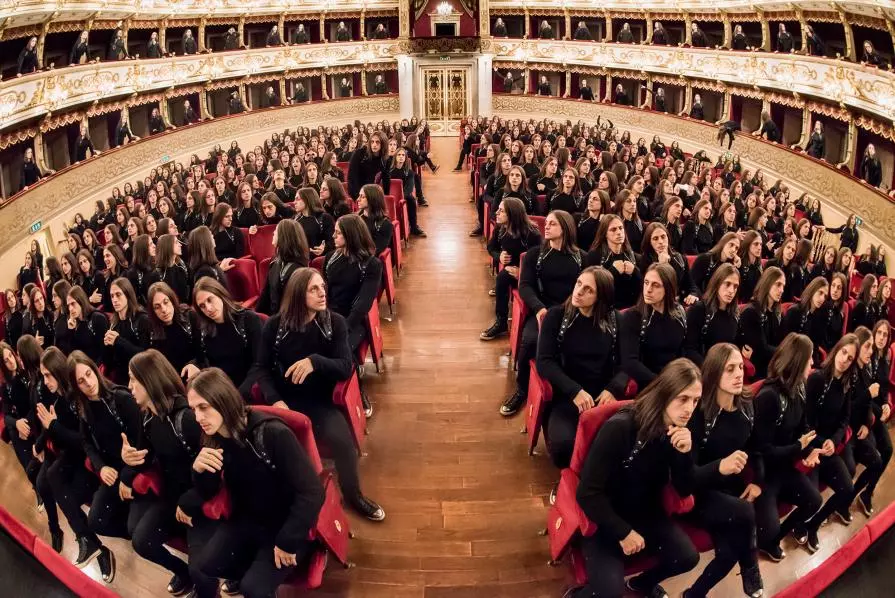
Super Ego
Of course, in every self-portrait there may be that certain narcissistic element, which can be considered in its most obvious valence, as an excess of self-love. Perhaps there is also something of the kind in this work by Marco Circhirillo, although tempered by an ironic and exuberant exhibitionism that softens, and makes easier to digest, the profound and disquieting message that, as we will see, it contains. The fact is that in general, in the psychic dynamic of the self-portrait, other aspects prevail to a much greater degree. These aspects, which draw from the sphere of psychically multi-faceted narcissism, involve complex and, in certain respects, contradictory mechanisms. The self-portrait, on the one hand, evokes our most ancient identity issues and repeats, to a certain extent, the most troubled processes in ego development. Here, however, merge the most creative aspirations bound to the need to manifest and exhibit a rich plurality, which at times characterizes the expansion and multiplication of our subjectivity. On the other, as is often remembered, this constitutes a desperate challenge to death. As our artist, who has often played skilfully and most ably with the theme of the Double knows, the self-portrait is perhaps the example that best represents the intrinsic ambivalence of the self-portrait. That disturbing something, that Unheimliche, is thus generated, which contains the fear of death and the will to deny it, or rather, counter it with the presence of another subject, which magically survives us through the duplication of the image; the evidence of death itself approaching, which, however, is recalled precisely by that uncontrolled compulsion to create one’s self-portrait and this has always marked an important part of our creativity; and the reconciliation with death through the constant relationship with the mirror which, according to Cocteau’s Orpheus formula, is nothing other than a way to familiarize oneself with the essence of transience: “Watch yourself all your life in a mirror and you’ll see Death at work like bees in a glass hive.”
But let us take a closer look at this self-portrait in its immediate complexity and let us get carried away with some free associations. We see, once again, how the sensibility of the artist and his intuitive capacity are capable of connecting and, to a certain degree, enhancing mutually the formal and stylistic efficacy of the work and its psychological depth.
Now, let us see how the form itself of this majestic representation, in its manifested and slightly forced circularity (the result in part of a distorted perspective of the cut of the photograph), appears to allude to the pleasing rotundity of a reassuring container – a Great Uterus, the archetype, that is, which lies at the heart of that primary and confusive narcissism of when the Ego is not yet split and feels at one with the whole. But the initial impression, or rather the immediate visual impact, is that of a large break in the centre of the circle (which corresponds with the central aisle of the seating …) which virtually creates the idea of an explosion. This “narcissistic explosion” causes, on the one hand, this spectacular ego proliferation but, on the other, more concretely, appears to allude to a radical separation, a cleft. This is where the Ego (or more precisely, the Ego of the subject) is truly split into two parts, which distance themselves from each other as in the image of the sea that opens to allow the passage of Moses. It is in this way that the strength of the work and its revelatory power stage the real splitting of the Ego that, as Freud maintained in relation to the unconscious, always recites and speaks many dialects. But if we continue to observe the picture, this movement, this distancing of the two halves of the image, appears in part to be contradicted by the fact that certain of these Egos, and each one in its own way, is watching or perhaps looking for his Ego in the next row. It is as if, in spite of the evident central fracture (in substance the splitting of the Ego), it wanted to attempt to maintain contact, a relation with the other or the other parts of itself. But it is just an impression. In reality, each of these Egos is tragically alone, there are no (and can never be) relations between them; so alike, so close, yet strangers, with no real possibility of communicating or making contact. Indeed, if visually the technique used for the construction of the image implies the idea of effective physical proximity (they are, after all, sitting next to one another!), the idea of any form of relationship is immediately contradicted by the realization that in reality each of these subjects is isolated, autonomous, and dramatically alone. Moreover, this crowd, this multiplication of the image, which would have wanted to celebrate the triumph of the Ego, ends up witnessing isolation, solitude, and insubstantiality. The radicality of this lack of communication and, at the same time, the need of which it is instead the expression, is evidenced by a particular detail of the image. In the left-hand row (that is to the viewer’s left), there is an empty seat, and that space appears to be the only point where certain subjects present effectively converge. And at the same time they appear to be looking and wondering what the meaning of that space is, as if it were expressing the wait for someone – of yet another Ego, and perhaps the only one which would finally be capable of giving a meaning to all this theatre. But it is just an impression, because in reality each one is looking per se, and that space is destined to remain as such forever, a fixed point monumentalized by the proof provided by this absence of which the photograph bears witness.
Let’s now look at the photo from a different perspective. We must imagine that the audience, in this theatre of the absurd – a point which needs reiterating – is made up of over three hundred Egos of Marco Circhirillo waiting for some show which sooner or later will commence. We cannot see the stage, and we do not know what sort of show is to be staged: the fact of the matter is that nobody in this paradoxical audience appears to be truly looking ahead – not to mention those strange improvised movements in the box seats of which we can only catch glimpses. It is as though the scheduled event were neither important nor imminent, giving us therefore the impression of a wait that is meaningless, in vain, as if it were basically a pretext. Then again, it would be no surprise if we were to discover that even on that invisible stage there were more Circhirillos, each one ready to recite his part just to himself without even attempting to communicate with the distracted and slightly snobbish audience made up of his other Egos. After all, the entire construction of the image, in the radicality of its perspective, is inverted and does not look towards the stage, but converges on a closed door. There is no way out, therefore, but there is the risk, perhaps, of an ironical accident, the tripping over of that pair of outstretched legs in the third last row. Because, deep down, even though with a certain melancholic air, it is precisely like a game, where the artist’s skilful technique frees our disillusioned desperation along with his. Yes, because in this theatre filled completely with his masks, in the original mirror of his Egos we also appear: the addressees, spectators, and perhaps involuntary directors of this evident mise-en scène.
Finally, a few words on the technique adopted by the artist or, better still, on the conceptual meaning. This re-proposes old issues concerning the ambiguous statute of photography which, although principally being substantially an “index” (material imprint of a real body), has always been capable of giving “body” also to our fantasies and our dreams. Of course, the whole image that we see here, like previous multi-portraits by the artist, does not correspond to an effective reality – there has never been, and there never can be a theatre filled with numerous Marco Circhirillos. And yet, each one of these images is effectively the visual imprint of Marco’s body sitting, shot after shot, in each of those seats. However, from this point of view there is no trickery, the image is real – as it is in every true photograph. And real, too, is the concern, but also the pleasure and admiration of the spectator who feels entrapped in this pretence, which is so real. After the initial wonder and appreciation, he allows himself – without realizing – some less pleasing reflections (although made more acceptable by the aesthetic illusion) on the sense also of his own identity and perhaps, with a certain levity, on the sense of worldly things.
Stefano Ferrari
 Share / Save
Share / Save



















Comments 0
Say something